09 October, 2023
PERGOLAS
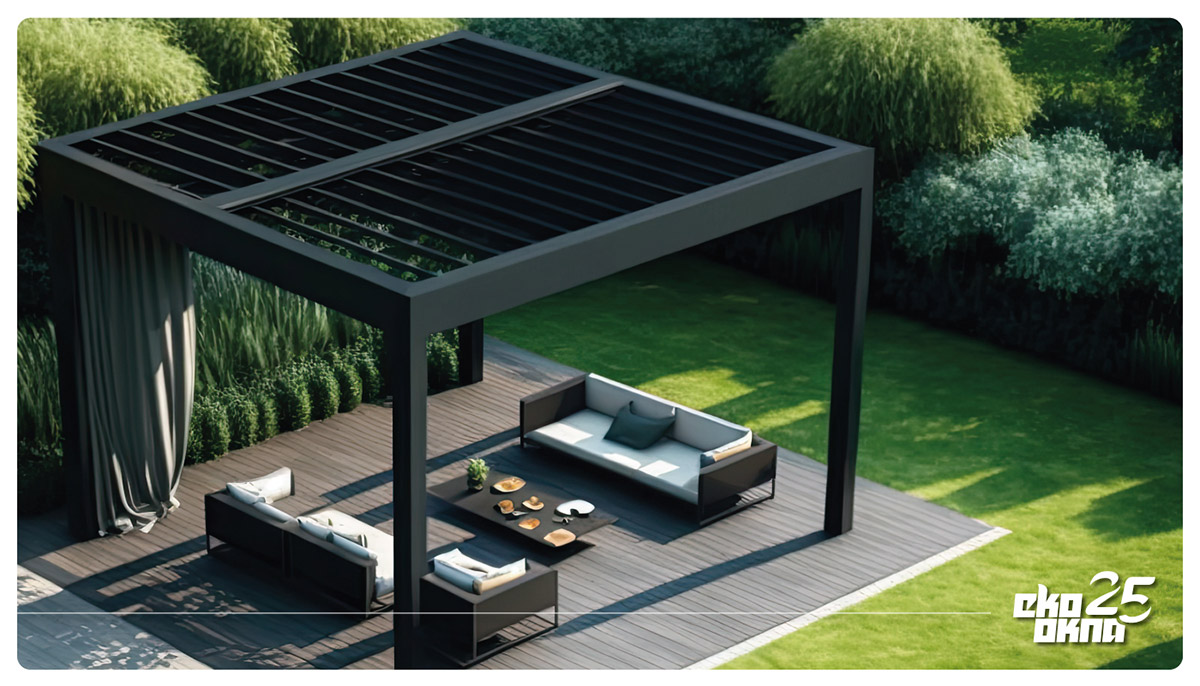
Pergola is an approachable name for lamella roofs. It is preferable to use this Italian word with Latin origins than technical jargon, as it is more fitting for this exceptionally pleasing addition to terraces and, particularly, gardens. Such a stylish decoration offers vast possibilities, especially if we choose a rich version and furnish it rightly. How to go about it and what to aim for? Let's find out.
Pergolas are still uncommon outdoor furnishings, at least in countries with cooler climates. We'll chance more of them in warmer places, but without getting ahead of ourselves, temperatures are no longer a problem today. Quite the opposite. Aluminium structures with roofs made of lamellas, whose presence is growing in our environment, can be divided in various ways. There are usually three types of such pergolas:
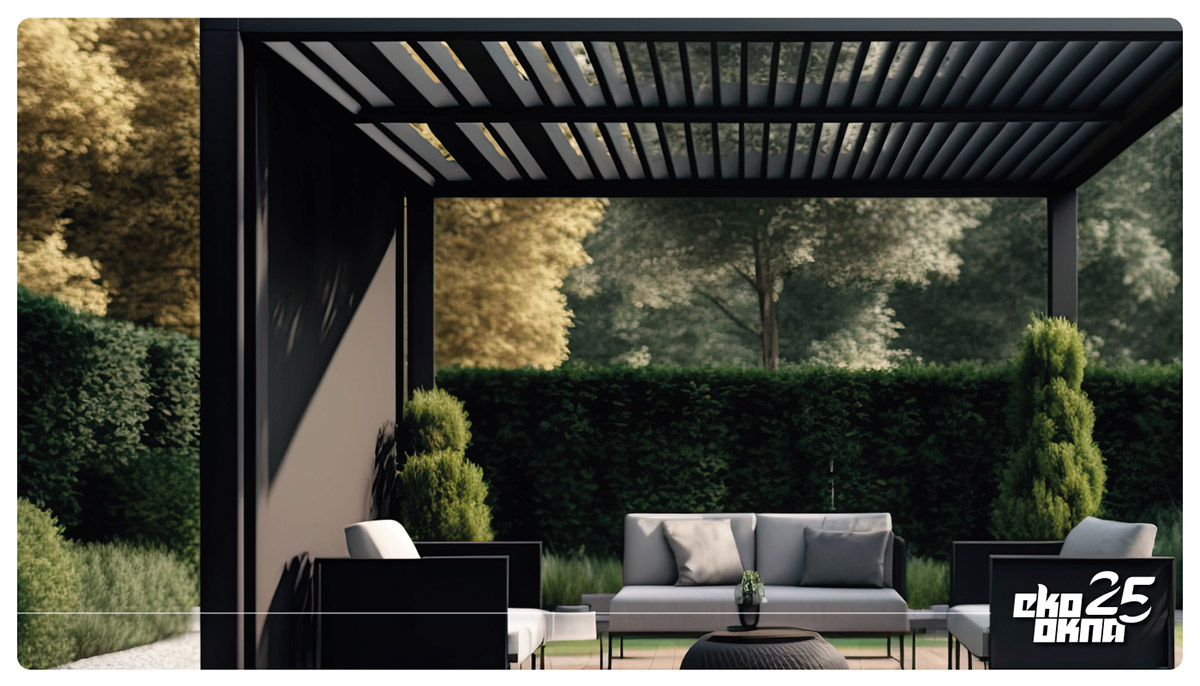
In gardens, we are least likely to see suspended models, which we use mostly to cover narrow passages between buildings. They are a remarkable idea for arranging home space, but we rarely have the opportunity to use them.
Whether to use free-standing or attached pergolas is more an issue of garden size than anything else. When we are limited to a small leisure space directly leaning against a building, an extension of the living room, we will create an element adjacent to the wall. When we have a large garden, a free-standing pergola will be best. Or perhaps both at once.
The second distinction that impacts how we use pergolas is how their lamellas move. Here we have:
In both versions, the roof consists of lamellas that rotate from a position of 0° to at least 90°, typically 115-135°. Such range makes it possible to build a uniform flat roof or open it up by aligning the lamellas vertically. Choosing the latter option, we can retract it completely, just like with blinds on windows. When we opt for the former, the lamellas rotate in place and do not move.
This distinction does not so much affect the arrangement of the garden as it does the shadow cast by the pergola. Even when we set its lamellas vertically, they still cast shadows unless we retract them.
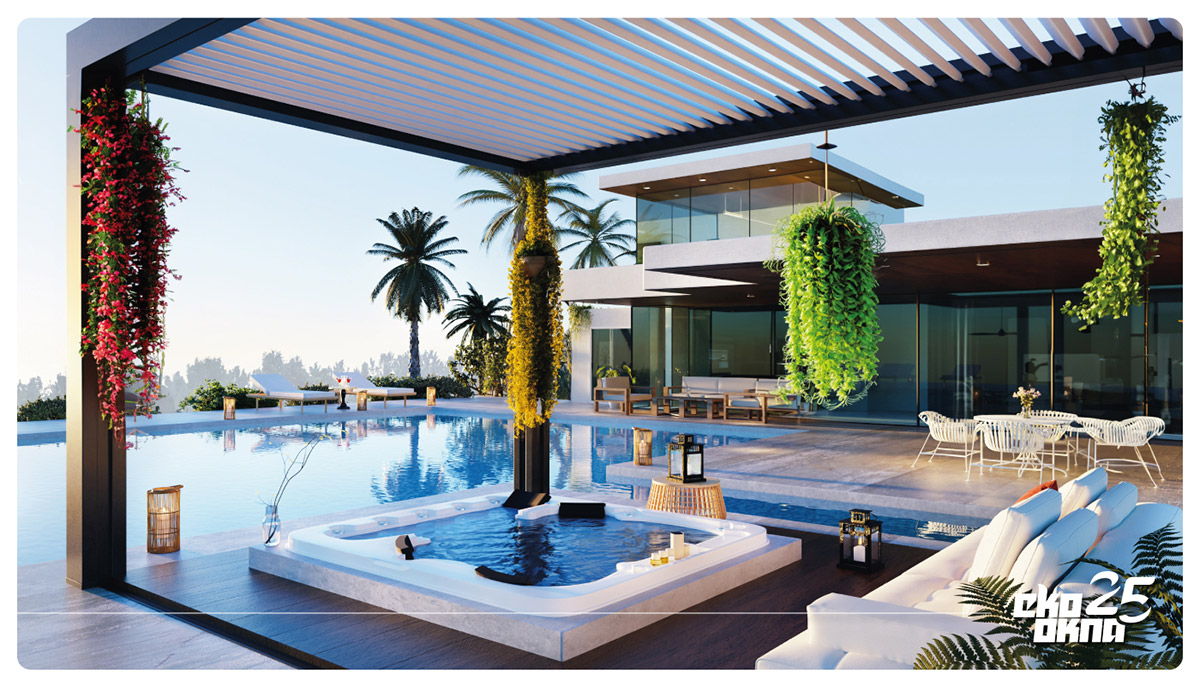
As we already said, pergolas are simple and even minimalist structures, as befits modern gardens. It is the unpretentious concepts of garden spaces that they support best. When we decorate them lavishly, though, they can also work well in luxury settings.
A typical pergola comprises four slim legs and a flat and simple yet movable roof. Building-attached pergolas typically have fewer legs, while suspended versions have none. There are more only in structures with a several-metre span. Interestingly, drainage systems are hidden in the legs, allowing water to drain seamlessly.
That's all in terms of the essence of pergolas, but we are far from having explored their full potential. Pergolas offer a variety of accessories that can relate to controlling the conditions around them and creating a pleasant atmosphere inside.
Winter gardens are thrilling, blending uniqueness and grandeur, even though they can significantly strain household finances. Well-chosen pergola accessories and decorations, especially those with a prominent functional component, allow us to turn them into a valuable substitute for typical winter gardens.
Creating walls around the pergola will help us in this endeavour the most. We can do it, e.g., with the help of sliding systems. Pergola's structure is too weak to accommodate traditional doors and windows, but sliding options work superbly here.
The accessories for pergolas that help us create a small winter garden can vary, from classic options located at the intersection of the house and the outdoors to indoor systems like Slide Glass. With the latter, we won't create a winter garden per se, but we don't always have to set our goals so ambitious.
If among the decorative elements whose function outshines design, we will obtain an effectively heated interior that will pamper us with pleasant warmth all year round. Infrared radiant heaters are safe and practical. They require only electricity to heat an interior in a few moments, provided the space is closed from above by lamellas with additional sealing.
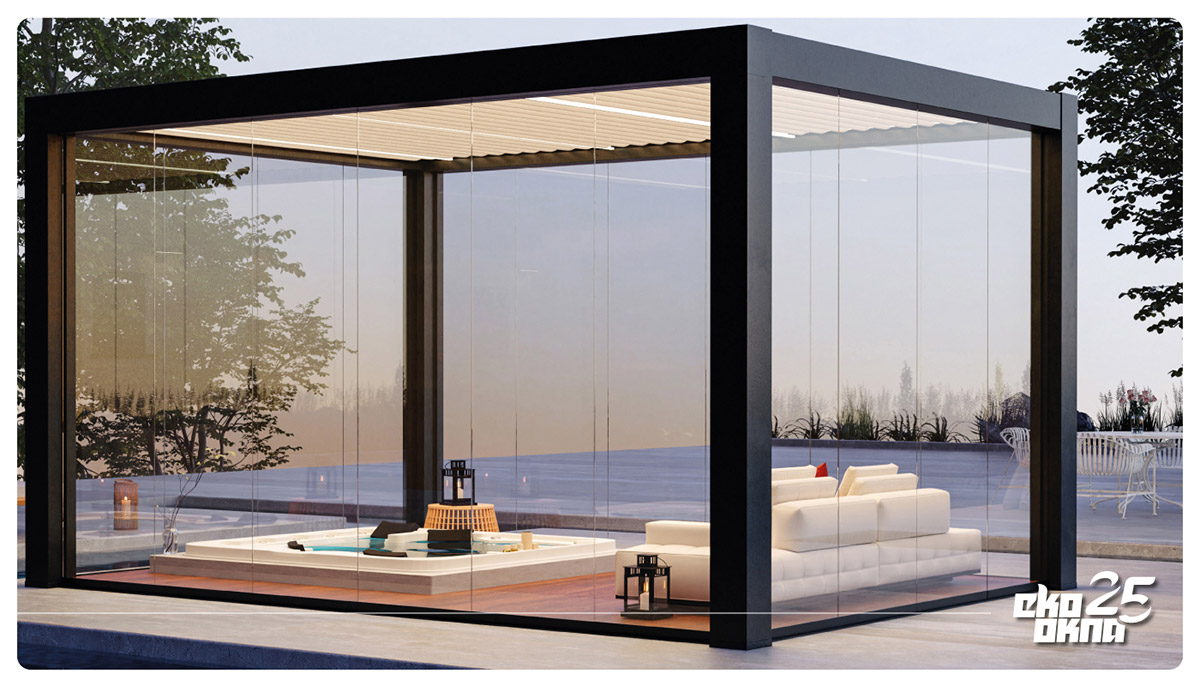
We don't have to fixate on winter gardens. In our terrace or garden arrangement, we can envision anything, be it "only" a delightful place to spend time in the warmer months of the year.
We can even install infrared heaters without walls because they heat not the air itself but the objects they radiate at. Under a pergola, this means us. There are also always screen blinds and shutters, which will shield us from the wind and, at the same time, provide privacy.
Like in a winter garden, a light pergola can host wireless speakers or garden lighting.
Pergolas are typically illuminated with LEDs, either strip or point light sources, the former providing more diffused light. We can hide them in lamellas, on them, or on the legs that support the structure.
Music is another way to make our time under pergolas more pleasant. We can describe speakers as decorations for pergolas because they are aesthetically pleasing on their own. We mount them on dedicated bars that replace part of the lamellas since the speaker should not rotate and retract. We can naturally also take advantage of many other, more versatile options for having speakers. Still, their integration into lamellas or posts is the simplest and most effective if only the type of pergola allows it.
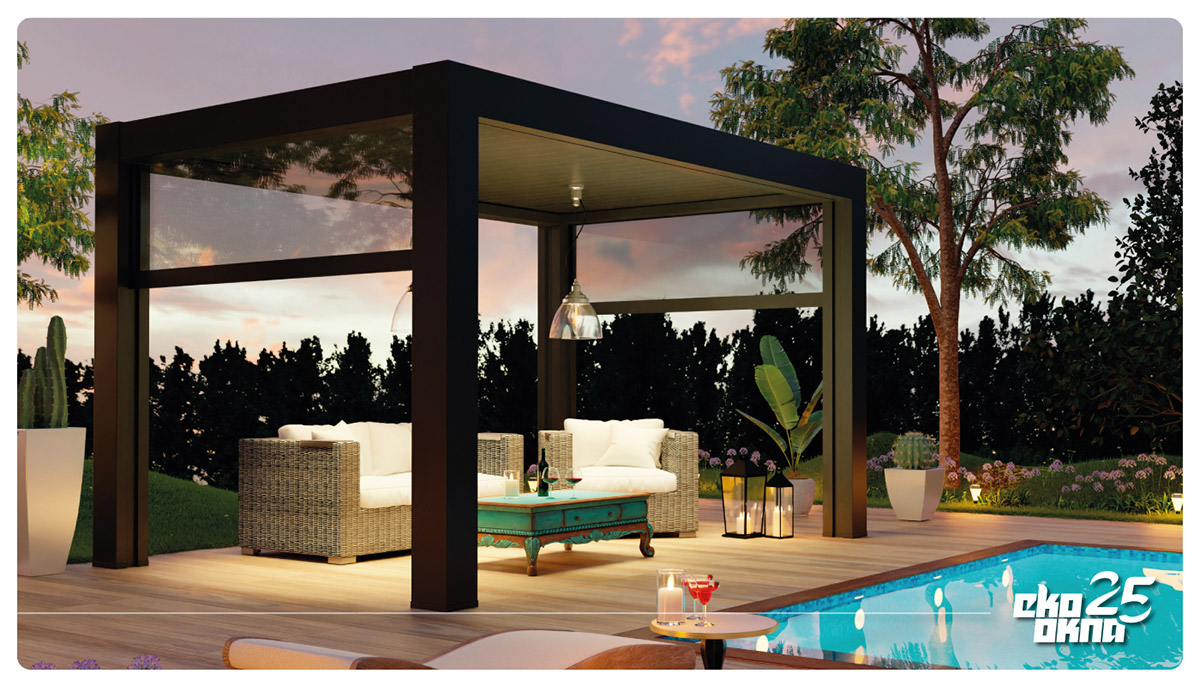
Furnishing a pergola is as good an idea as any and even a necessity if we hope for true comfort. We should remember, though, that even well-built pergolas are a part of the terrace design or an element included in the garden design. It is not the interior of the house.
For this reason, rattan or, better, synthetic rattan garden furniture suits them best. Garden furniture manufacturers have not forgotten about people who like a little more comfort, so much furniture includes specialised cushions we take home when our pergola time is over. All the chairs and sofas stay outside.
Although plants complement pergolas perfectly, we must not approach them with indifference and choose them randomly. When creating garden designs incorporating plants, let's take a moment to consider the appropriate flora for pergolas.
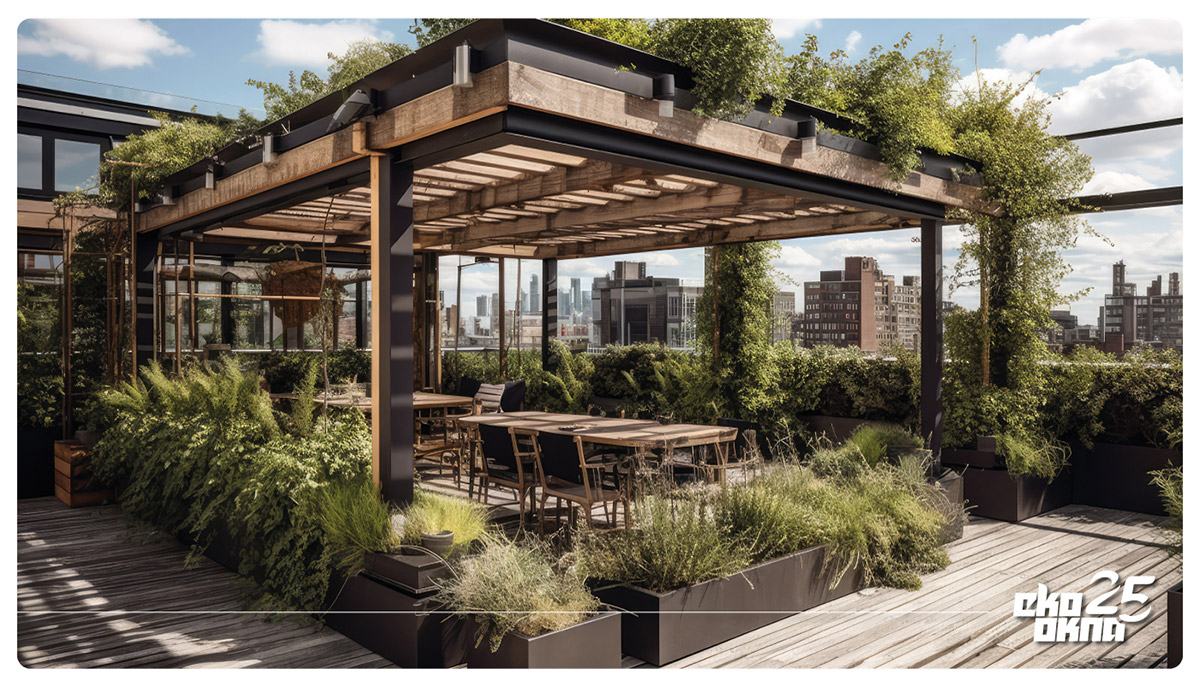
Contrary to popular belief, these should not be vines at all, or at least we should not let vines grow unchecked. Robust woodbines, trumpet vines, and Fallopia aubergine are widely favoured for small garden architecture as they develop rapidly, bloom beautifully, and are easy on the eye. These plants may cause an issue on modern pergolas, though.
When opting for vine plants, we need to be careful as they can grow so large that they block the movement of the lamellas. They can also interfere with the roller shutters or sliding systems we may use to create pergola walls.
To stay on the safe side, we may opt for flowers borrowed from our balconies and hang them on the structure of our pergola. Numerous potted plants seem designed for just such use. The choice of vines for pergolas should be accompanied by dedicated fixtures to support them or will require regular maintenance to ensure they grow in the desired direction.
With a typical pergola, we will receive a remote control, which, like remotes for blinds or shutters, will allow us to open and close the roof. When other functions are available, such as the already mentioned LED lighting or Bluetooth audio systems, it's handy to control everything from an app on a smartphone. In that case, we're already discussing a sophisticated home automation system, a smart pergola, to coin a phrase.
Like other systems with smart control mechanisms, pergolas can be largely independent. All they need is a weather station that responds autonomously to specific signals.
The modern pergola is no longer just a static piece of garden infrastructure. As stated earlier, it has moving lamellas that can rotate on their own axis or even roll up like their counterparts in facade shutters. We can control their actions ourselves or we can leave it to automated systems.
With a typical pergola, we will receive a remote control, which, like remotes for blinds or shutters, will allow us to open and close the roof. If our pergola has other functions, such as the aforementioned lighting or Bluetooth audio systems, it's a good idea to control everything from an app on your smartphone. Then we are already talking about a smart home system. In this case – a smart pergola.
Like all other systems with smart control mechanisms, pergolas can be largely independent. All they need is a weather station that responds autonomously to a set of specific signals.
What are the signals that trigger an autonomous response of the pergola? Primarily these are:
By far, the most important are the first 2, as they are directly related to the safety of the pergola.
We are talking about a relatively lightweight structure with a large flat surface prone to being blown away when the laths are at 0°. The wind sensor in the pergola will set the lamellas to 90° (vertically) whenever wind gusts exceed the threshold to prevent damage.
Each pergola also has a permissible snow pressure, beyond which the lamellas begin to deform, and the structure may even risk collapse. Differences in strength between various products and configurations are significant. The tolerable weight of snow ranges from just a few tens of kilograms per square metre of the roof to well over 100kg. We should always position the lamellas vertically whenever there is a chance of snow to prevent any potential issues.
We do not have to do this manually, of course. A weather station will also do the job for us when it detects rainfall at water-freezing temperatures.
Temperature and sunlight detection will also translate directly into our comfort. Closed lamellas mean shade and coolness, and open ones mean more heat. Regardless, most users tend to control their pergolas manually, relying on automatic systems only when they are not around or busy.
What to do with it for the best effect? Anything! The most substantial advantage of a pergola is its versatility. It creates space, and space is an invitation to act.
The two main trends for tackling this potential are the isolation of a comfort zone and the improvement of the garden.
The comfort zone should be enclosed, using at least screen blinds, to protect us from prying eyes, wind, and all the wicked outside world. Let's bring in music and good lighting, set up infrared heaters, and create a homey enclave outside the house.
When we create a tranquil garden retreat, we should let plants take centre stage. Let's not separate ourselves from nature but welcome as much of it as possible. Let's also not be afraid of vine plants. Even though we shouldn't allow them near the lamellas, we can accommodate them by creating additional structures, racks or even simple strings on which they can lushly climb.
Only our creativity will set the limits.

Hotline:
+1 917 810 8657 +48 572 337 243 Connection fee in accordance with the operator`s price list.
Eko-Okna S.A.
Kornice, ul. Spacerowa 4
47-480 Pietrowice Wielkie
NIP: 6391813241, KRS: 0000586067